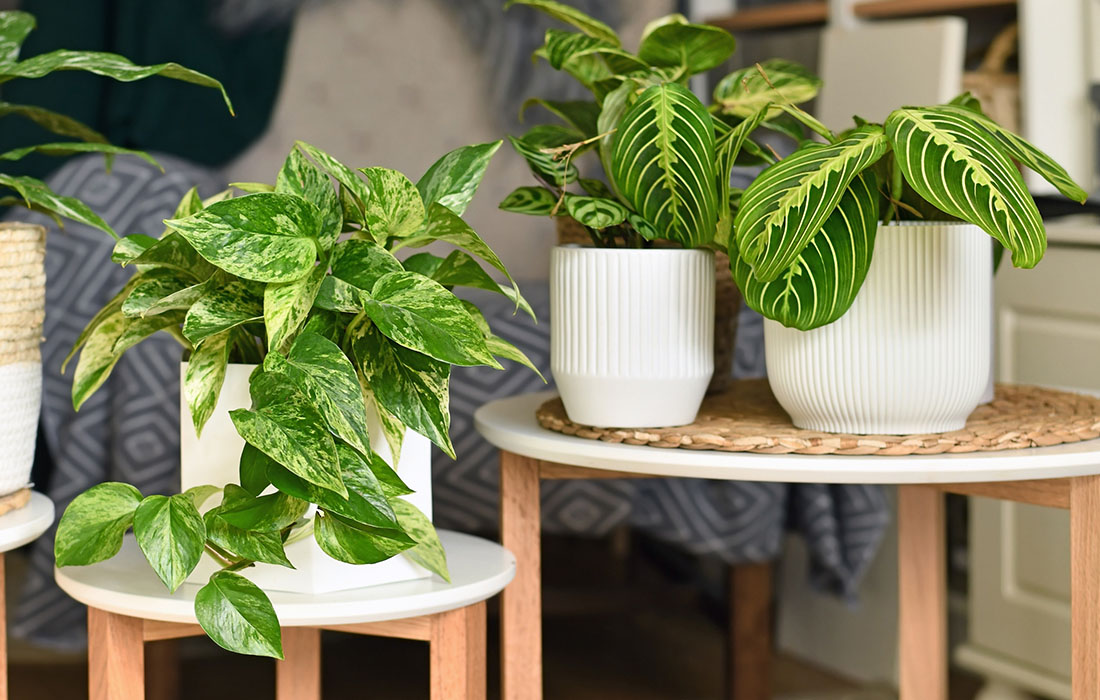When warm weather arrives, you might think this is what your plants have been waiting for. Which is partially true, as most plants require sufficient warmth and light to thrive. The optimal temperature ranges for most plants are between 59 and 85°F (15 and 29°C). However, higher temperatures may slow down plant growth, lead to serious stress, and even kill your plants.
Check out the following signs of heat stress in both indoor and outdoor plants.
Wilting

Alongside with leaves turning yellow and developing brown spots, wilting is usually the most common sign of heat stress. Many plants will bounce back when temperatures go down in the evening. However, the damage gets worse if plants remain shriveled for longer periods.
Leaf Rolling

The plants’ response under such conditions is leaves rolling, cupping, curling up and down. Plants do that to minimize the leaf surface area and mitigate moisture loss.
Dry Leaf Edges

The outer edges of a leaf will dry up, while the entire leaf remains vigorous. Large-leaved plants resort to this survival mechanism, which allows them to function properly thanks to a significant surface area.
Flower, Bud, Leaf, and Fruit Drop

Excessively high temperatures may cause bloom and fruit drop in vegetables, bud and flower drop in many ornamentals, and leaf drop in trees. This lets the plants save resources to survive blazing heat. Budding and fruiting will resume when it cools down.
Bolting

Sweltering heat causes bolting (premature blooming and seed production) in cool-season crops. To get the best quality and flavor, you may want to pick your veggies and leafy greens before a heat wave.
Fruit and leaf scald

Discoloration of fruit and leaf tissue, blisters, and hardened areas on fruit and leaves—all these are signs of sunscald. It usually affects the sun-exposed side of the plants. Damaged plants are more prone to pest infestations, and they’re more likely to become sick.
Here’s how to prevent heat stress and revive your plants

- During hot spells, give your plants a soak early in the morning or evening to limit the amount of water that evaporates during the day. However, water damaged plants immediately to minimize the time spent in a withered condition. Choose deep watering over shallow and avoid cooling plants down by spraying them over with cold water.
- Providing extra humidity may be beneficial for many plants when high temperatures linger. Consider misting the leaves using a fine mist sprayer, while a pressure mist sprayer gets the job done if you have large plants or a group of them.
- Shield your plants from the sun with a shade cloth or move your pots out of the sun if possible.• Growing plants in fabric pots, which are more breathable, will keep their roots cool. Mulching with a cooling material is another way to limit the amount of evaporation. Mulch also breaks down over time and adds organic matter to the soil, giving your veg beds and containers a well-needed boost for the summer. This is especially beneficial for young plants and those with shallow roots, as these will be most affected when the topsoil is parched.
- Using certain nutrients may work wonders on your plants, helping them withstand heat. Silica, for example, increases resistance, while seaweed kelp extract acts as a good preventative measure, and it may also aid recovery from soaring temperatures.
- Keep the area around the plants weed-free during hot spells, too, as many weeds will compete with plants for water, nutrients, and light.
With that said, there are activities you should avoid on hot days

- Planting and repotting stress out plants—as hot soil may cause blight where the stem and the soil line meet—or even kill young seedlings. Put off these jobs until cooler temperatures arrive.
- During oppressive heat, removing leaves and branches will reveal a new part of the crown, and this may scorch the leaves that were previously sheltered.
- Feeding plants during droughts isn’t the best idea because they won’t take up the nutrients. As a consequence, the feed will remain in the growing medium, and when the temperatures drop and you feed again, the plants will get a double dose of food.
- When temperatures rise above 85ºF (29°C), treating your plants for diseases and infestations may damage them even more. Always check the label before applying any product.
Take note that other conditions may resemble heat stress. Overwatering, for instance, may often cause curling and discoloration of your plants’ foliage, pests might be the culprit if leaves start falling off, and dry leaf margins may indicate a disease.
So, stay vigilant to prevent and reduce the negative effects of heat stress to grow healthy and happy plants for many seasons to come.
